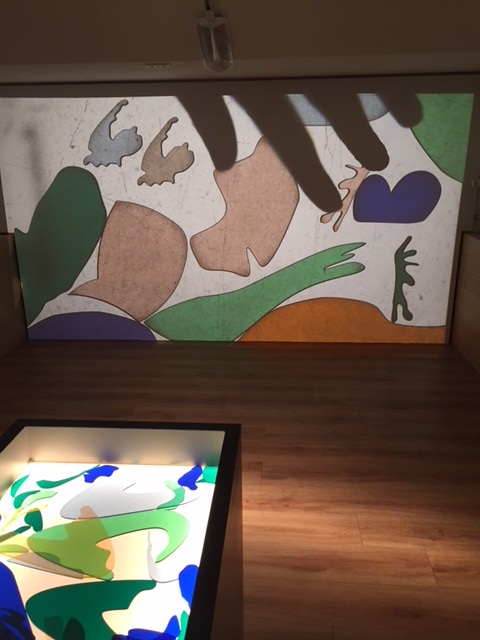Everyone, including me, who ever visited a modern or contemporary art museum can get a little bit confused by its content. ‘How can this be art?’ ‘What has this to do with art history?’ or ‘How can you find this just as beautiful as the great works of Rembrandt or Da Vinci?’ are questions that can pop up inside your head as you walk along the plain white walls with abstract paintings on them. Modern art can be difficult to understand and to admire, and that is why I think it is important for a museum of modern art to clarify its content for a broad public.
As a person who always had a great interest in modern art, I thought it would be interesting to analyze the digital tools and media that are being used at the Stedelijk Museum in Amsterdam. In this case, I chose to examine the temporary interactive exhibition, which is called ‘Beam Beam Base’. At first, I thought it would be some kind of game for kids to get a grip on the works in the museum, but when I paid a visit I was totally surprised.
The Beam Beam Base project is a part of the Rabo Lab. This is a place in the Stedelijk funded by Rabobank Amsterdam, in which time to time different interactive projects are situated. The Rabobank is since 2011 the main sponsor of the Stedelijk and signed an extension of the contract for three more years last February. The article about this sponsorship states that ‘thanks to Rabobank Amsterdam, the Stedelijk can be a museum for and from everyone.’ From this article, it becomes clear that the Rabo Lab (including Beam Beam base) is focused on families and children, with as main goal to find deepening with one of the exhibitions. I think this is a good mindset, but the Beam Beam Base project is in my opinion not just something that children will enjoy. When I paid my visit for example, there were only people of my age (22) or older. But the goal of the project is definitely admirable.
Beam Beam Base is a digital and analogue environment with about five different beamers in different sizes, with underneath the reflectors a pile of Plexiglas. You are able to move the pieces in the way that you like, ‘to play with form like Malevich or to represent music as Kandinsky’ as the website of the Stedelijk puts it. The composition is then being projected on the wall. So, understanding the art and the history of it is not just about information that you learn from the signs next to the artworks, or something that you read in a book. You can experience the artworks in your own way and maybe, as I see it, get a little bit closer to the artist himself.
The Beam Beam Base is at the end of the ‘normal’ exhibitions in the Stedelijk. I think this is a smart move of the museum, because you already learned about the paintings and afterwards you can try to ‘recreate’ them at the interactive exposition. The digital strategy that the Stedelijk uses to awaken an interest for expressionist and abstract art is something that I find quite unique. It is not new though, that in a lot of (modern art) museums, digital tools are being used to ‘spice up’ their content. Big screens in HD quality, free audio tours, virtual reality and iPads next to artworks; almost every museum, including the Stedelijk, has fallen prey to the digitalization of our time. Next to that, the Stedelijk makes use of mediakunst.net, a digital catalogue that ‘unites the media art collections from the participating institutions’.
But, going back to the Beam Beam Base project, I think that the way that the Stedelijk uses modern and at the same time analogue beamers with which you can make your own art. It is digitalization in a kind of an old-school way, which I think is very nice. Next to that, you can publish your own work of art on social media. When you tag the Stedelijk, they will post your art in large on the walls of the museum, so you can share your creativity with other people.
When I look at the project from an esthetic view, I think that it is well designed and with a good eye for kids. There are a lot of little stairs and the beamers are on platforms, so kids can have easy access to it. But also for adults this project is very enjoyable, as you can experiment with different forms, shapes and colors in a way that a kid won’t necessarily do.
Unfortunately, apart from the published articles about the Rabobank sponsorship of the Stedelijk and other projects that they made, there are no specific secondary articles that I could use to analyze the Beam Beam Base project. Apart from that, I hope that I could have made a clear analysis of this digital (art) history project and that I clarified the impact of the digital strategy on the historical interpretation of a modern art museum.
Thanks for reading!
Anna Helfrich
https://www.stedelijk.nl/nl/evenementen/lab#slideshow-36890
https://www.stedelijk.nl/nl/nieuws/rabobank-verlengt-hoofdsponsorschap
http://mediakunst.net/#/home/loggedoff
https://marketingfuel.nl/rabobank-blijft-hoofdsponsor-van-het-stedelijk-museum/


